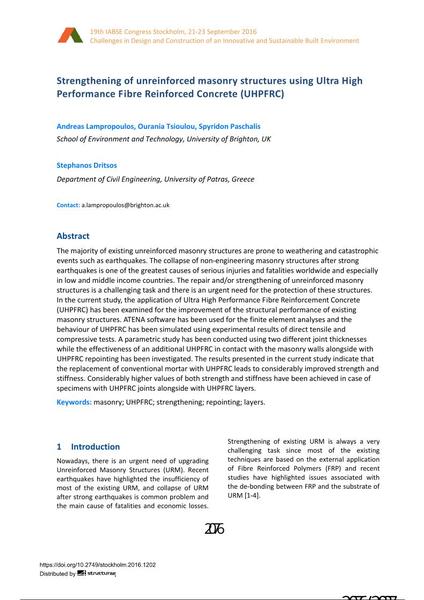Strengthening of unreinforced masonry structures using Ultra High Performance Fibre Reinforced Concrete (UHPFRC)

|
|
|||||||||||
Détails bibliographiques
| Auteur(s): |
Andreas Lampropoulos
(School of Environment and Technology, University of Brighton, UK)
Ourania Tsioulou (School of Environment and Technology, University of Brighton, UK) Spyridon Paschalis (School of Environment and Technology, University of Brighton, UK) Stephanos Dritsos (Department of Civil Engineering, University of Patras, Greece) |
||||
|---|---|---|---|---|---|
| Médium: | papier de conférence | ||||
| Langue(s): | anglais | ||||
| Conférence: | IABSE Congress: Challenges in Design and Construction of an Innovative and Sustainable Built Environment, Stockholm, Sweden, 21-23 September 2016 | ||||
| Publié dans: | IABSE Congress Stockholm, 2016 | ||||
|
|||||
| Page(s): | 2076-2083 | ||||
| Nombre total de pages (du PDF): | 8 | ||||
| Année: | 2016 | ||||
| DOI: | 10.2749/stockholm.2016.1202 | ||||
| Abstrait: |
The majority of existing unreinforced masonry structures are prone to weathering and catastrophic events such as earthquakes. The collapse of non-engineering masonry structures after strong earthquakes is one of the greatest causes of serious injuries and fatalities worldwide and especially in low and middle income countries. The repair and/or strengthening of unreinforced masonry structures is a challenging task and there is an urgent need for the protection of these structures. In the current study, the application of Ultra High Performance Fibre Reinforcement Concrete (UHPFRC) has been examined for the improvement of the structural performance of existing masonry structures. ATENA software has been used for the finite element analyses and the behaviour of UHPFRC has been simulated using experimental results of direct tensile and compressive tests. A parametric study has been conducted using two different joint thicknesses while the effectiveness of an additional UHPFRC in contact with the masonry walls alongside with UHPFRC repointing has been investigated. The results presented in the current study indicate that the replacement of conventional mortar with UHPFRC leads to considerably improved strength and stiffness. Considerably higher values of both strength and stiffness have been achieved in case of specimens with UHPFRC joints alongside with UHPFRC layers. |
||||
| Mots-clé: |
renforcement
|
||||

